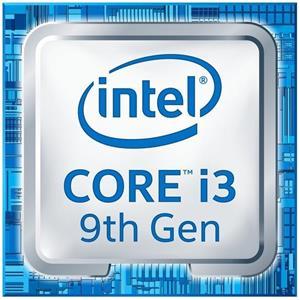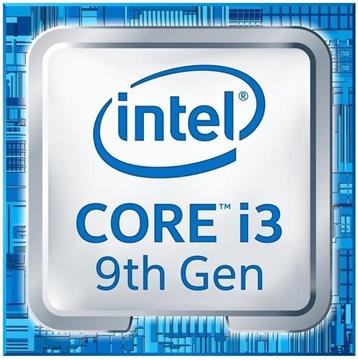Intel S1151 CORE i3 9100F TRAY 4x3,6 65W GEN9
Proizvod nije dobavljiv. Potražite neke druge modele koji su zamijenili Intel S1151 CORE i3 9100F TRAY 4x3,6 65W GEN9
| Proizvođač: | Intel |
| Šifra: | 1340585 |
| Kataloški broj: | CM8068403377321 |
| Jamstvo: | 36 |
Prosječna ocjena:  0,00
| Glasova:
0
0,00
| Glasova:
0
|
| Ocijeni
ovaj proizvod
|
Intel Core i3-9100F Processor (6MB Cache, up to 4.2 GHz)
Processor manufacturer Intel
Processor generation 9th gen Intel® Core™ i3
The model number for the processor in a computer. Processor model i3-9100F
Processor base frequency 3.6 GHz
A family of processors is a group of processors produced by one company over a short period of time e.g. Intel Pentium processors. Processor family Intel® Core™ i3
The number of central processing units ('cores') in a processor. Some processors have 1 core, others have 2 (e.g. Intel Core Duo) or more (e.g. the Intel Xeon E7-2850 has 10 cores). Processor cores 4
Mechanical component(s) that provides mechanical and electrical connections between a microprocessor and a printed circuit board (PCB). This allows the processor to be replaced without soldering. Processor socket LGA 1151 (Socket H4)
What this product is used as a part of (component for). Component for PC
The process which is performed by the processor e.g. CPU (Central Processing Unit). Processor lithography 14 nm
Processor threads 4
A bus is a communication system that transfers data between components inside a computer, or between computers. The system bus rate is the speed at which data is transferred in this communication system. System bus rate 8 GT/s GT/s
Operating modes for the processors that place restrictions on the type and scope of operations for certain processes run by the CPU. This design allows the operating system to run with more privileges than application software. Processor operating modes 64-bit
The turbo boost is an automatic, managed accelleration of the processor when one of the cores is overloaded. Processor boost frequency 4.2 GHz
Processor cache 6 MB MB
Processor cache type Smart Cache
Thermal Design Power (TDP) 65 W
Plastic or metal shell/container for components. Box No
The device comes with an integrated cooler. Cooler included No
Generation 9th Generation
Memory bandwidth supported by processor (max) 37.5 GB/s
Processor codename Coffee Lake
Processor ARK ID 190886
Memory
Maximum internal memory supported by processor 64 GB GB
Memory types supported by processor DDR4-SDRAM
Memory clock speeds supported by processor 2400 MHz MHz
Memory channels Dual-channel
ECC means Error Correction Code, and it is memory that is able to detect and correct some memory errors without user intervention. ECC Yes
Graphics
Graphics hardware which is built into the motherboard or CPU, as opposed to a separate graphics adapter (video card). On-board graphics uses CPU and RAM for graphics processing. On-board graphics card No
Discrete graphics card No
Graphic adapter is the hardware that produces images on a display. "On-board" means that the graphics adapter is intergrated inside the motherboard. On-board graphics card model Not available
A graphics adapter (often known as a video card) generates images for a display. A discrete graphics adapter plugs into the motherboard, and usually produces much better graphics than an integrated graphics adapter. There are various models of discrete graphics adapters. Discrete graphics card model Not available
Intel® Optane™ Memory Supported
Intel® Optane™ memory is a revolutionary new class of non-volatile memory that sits in between system memory and storage to accelerate system performance and responsiveness. When combined with the Intel® Rapid Storage Technology Driver, it seamlessly manages multiple tiers of storage while presenting one virtual drive to the OS, ensuring that data frequently used resides on the fastest tier of storage. Intel® Optane™ memory requires specific hardware and software configuration.
Intel® Turbo Boost Technology
Intel® Turbo Boost Technology dynamically increases the processor's frequency as needed by taking advantage of thermal and power headroom to give you a burst of speed when you need it, and increased energy efficiency when you don’t.
Intel® Virtualization Technology (VT-x)
Intel® Virtualization Technology (VT-x) allows one hardware platform to function as multiple “virtual” platforms. It offers improved manageability by limiting downtime and maintaining productivity by isolating computing activities into separate partitions.
Intel® Virtualization Technology for Directed I/O (VT-d)
Intel® Virtualization Technology for Directed I/O (VT-d) continues from the existing support for IA-32 (VT-x) and Itanium® processor (VT-i) virtualization adding new support for I/O-device virtualization. Intel VT-d can help end users improve security and reliability of the systems and also improve performance of I/O devices in virtualized environments.
Intel® VT-x with Extended Page Tables (EPT)
Intel® VT-x with Extended Page Tables (EPT), also known as Second Level Address Translation (SLAT), provides acceleration for memory intensive virtualized applications. Extended Page Tables in Intel® Virtualization Technology platforms reduces the memory and power overhead costs and increases battery life through hardware optimization of page table management.
Intel® 64
Intel® 64 architecture delivers 64-bit computing on server, workstation, desktop and mobile platforms when combined with supporting software.1 Intel 64 architecture improves performance by allowing systems to address more than 4 GB of both virtual and physical memory.
Instruction Set
An instruction set refers to the basic set of commands and instructions that a microprocessor understands and can carry out. The value shown represents which Intel’s instruction set this processor is compatible with.
Instruction Set Extensions
Instruction Set Extensions are additional instructions which can increase performance when the same operations are performed on multiple data objects. These can include SSE (Streaming SIMD Extensions) and AVX (Advanced Vector Extensions).
Idle States
Idle States (C-states) are used to save power when the processor is idle. C0 is the operational state, meaning that the CPU is doing useful work. C1 is the first idle state, C2 the second, and so on, where more power saving actions are taken for numerically higher C-states.
Enhanced Intel SpeedStep® Technology
Enhanced Intel SpeedStep® Technology is an advanced means of enabling high performance while meeting the power-conservation needs of mobile systems. Conventional Intel SpeedStep® Technology switches both voltage and frequency in tandem between high and low levels in response to processor load. Enhanced Intel SpeedStep® Technology builds upon that architecture using design strategies such as Separation between Voltage and Frequency Changes, and Clock Partitioning and Recovery.
Thermal Monitoring Technologies
Thermal Monitoring Technologies protect the processor package and the system from thermal failure through several thermal management features. An on-die Digital Thermal Sensor (DTS) detects the core's temperature, and the thermal management features reduce package power consumption and thereby temperature when required in order to remain within normal operating limits.
Intel® Identity Protection Technology
Intel® Identity Protection Technology is a built-in security token technology that helps provide a simple, tamper-resistant method for protecting access to your online customer and business data from threats and fraud. Intel® IPT provides a hardware-based proof of a unique user’s PC to websites, financial institutions, and network services; providing verification that it is not malware attempting to login. Intel® IPT can be a key component in two-factor authentication solutions to protect your information at websites and business log-ins.
| Osnovne karakteristike | |
|---|---|
| Socket: | 1151 |
| Jezgra: | Coffee Lake (gen 9.) |
| Radni takt [GHz]: | 3.6 GHz |
| Broj jezgri: | 4 |
| Broj threadova: | 4 |
| Ostale karakteristike | |
| Integrirani grafički sustav: | Ne |
| Hladnjak: | Ne |
*Unatoč uloženom trudu da damo što bolji i točniji opis, slike i specifikacije, ne možemo garantirati da su svi navedeni podaci točni te ne odgovaramo za eventualne pogreške nastale u opisu proizvoda, slika ili specifikacija. Iste je potrebno provjeriti na stranicama proizvođača ili pošaljite upit našim djelatnicima da provjere.
Ukoliko na našoj stranici otkrijete neistinite odnosno neadekvatne informacije, molimo vas da nam to javite na prodaja[o]protis.hr
Za odabrani proizvod nije unesen niti jedan komentar.










